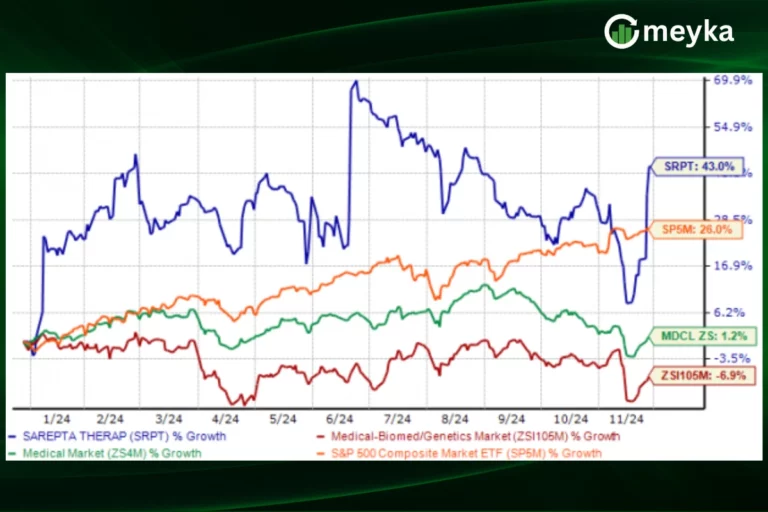Lulu Stock Sinks After Earnings Forecast Disappoints Investors
Lululemon’s shares, Lulu Stock, fell sharply after the athletic apparel retailer reported disappointing earnings forecasts for Q2 2025. Investors were surprised as the company lowered its full-year guidance, citing weaker-than-expected consumer spending, tariffs, and softer sales in key markets. The sudden decline in Lulu Stock rattled traders, prompting analysts to reassess the stock’s near-term potential.
Why are investors so worried? The drop in Lulu Stock reflects broader concerns about consumer demand in the retail sector and rising operational costs affecting profitability.
Background on Lululemon and Lulu Stock
Lulu Stock represents Lululemon Athletica Inc., a high-growth retailer specializing in premium athletic and yoga apparel. Over the past several years, the company has been praised for its innovative product designs, strong brand loyalty, and digital growth. Historically, Lululemon has outperformed many peers in the apparel industry, but rising competition and changing consumer habits have started to weigh on its margins.
Analysts often point to Lululemon’s strong e-commerce presence and loyalty program as strengths. However, recent global economic pressures, including supply chain challenges and inflation, have created headwinds for Lulu Stock.
Q2 2025 Earnings: Why Lululemon Cut Forecasts
Lululemon reported Q2 2025 revenue of $2.1 billion, slightly above consensus estimates, but the company slashed its full-year forecast. The management cited several reasons:
- Tariff increases impacting imported products
- Soft sales in the U.S. and international markets
- A slowdown in consumer spending in discretionary apparel categories
This earnings warning was unexpected by many market participants, triggering the sharp decline in Lulu Stock. According to CNBC, the stock fell more than 6% in early trading following the forecast revision.
Why is this happening now? Retailers are increasingly exposed to macroeconomic conditions, and Lululemon’s premium pricing strategy makes it more sensitive to changes in consumer confidence.
Market Reactions and Investor Sentiment
Investor sentiment turned negative almost immediately after the forecast cut. Many traders sold Lulu Stock on concerns that the earnings slowdown could continue into Q3. Analysts note that while Lululemon maintains strong fundamentals, market expectations for high growth have tempered sharply.
A tweet from @ValueByMarkus emphasized investor reaction:
Another social media update by @ecommerceshares highlighted concerns about broader retail pressures affecting Lulu Stock:
Analysts remain divided. Some see the drop as a short-term correction, while others warn of persistent margin pressures and slowing same-store sales that could weigh on Lulu Stock over the next quarters.
Stock Performance and Peer Comparison
After the earnings release, Lulu Stock fell from $420 to $392, representing a near 7% intraday decline. This underperformance was sharper than the broader retail sector, with peers like Nike and Under Armour seeing more moderate declines.
What does this mean for the retail industry? The reaction underscores the sensitivity of premium apparel brands to changes in consumer behavior, tariffs, and international trade dynamics. Investors are increasingly scrutinizing companies that rely on discretionary spending, especially as economic uncertainties continue.
Analyst Commentary on Lulu Stock
MarketWatch reported that analysts revised their target prices for Lulu Stock, citing the risk of slower-than-expected revenue growth. According to Sherwood News, factors such as higher operating costs and international tariffs are likely to remain challenging in the coming quarters.
A tweet from @KobeissiLetter reflects this sentiment:
Meanwhile, @TheTranscript_ noted that the sell-off in Lulu Stock may attract long-term investors looking for entry points, emphasizing the company’s strong brand positioning:
Digital Sales and Consumer Trends
Despite the stock drop, Lululemon continues to see growth in its digital channels. E-commerce remains a key driver for revenue, with the company reporting a 15% increase in online sales during Q2 2025. The management also highlighted successful product launches and loyalty programs, but these positive indicators were not enough to offset macroeconomic concerns.
A tweet from @Tlee1228 highlighted consumer confidence as a key factor influencing Lulu Stock performance:
For investors, the digital growth story provides some reassurance that Lulu Stock is not entirely exposed to physical retail pressures.
Industry-Wide Challenges
The athletic apparel sector faces broader challenges beyond Lululemon’s earnings. Rising material costs, global supply chain issues, and competitive pressure from other premium brands have created a volatile environment. Analysts emphasize that even companies with strong brand recognition, like Lululemon, are vulnerable when consumers cut back on discretionary spending.
What does this mean for long-term investors? While Lulu Stock remains attractive due to brand strength and digital innovation, careful monitoring of macroeconomic indicators and retail trends is crucial.
Video Analysis and Investor Insights
For a detailed breakdown of the earnings and stock reaction, the following YouTube video provides expert commentary:
The video highlights the key drivers behind the earnings disappointment, market reactions, and what investors can expect in the coming months. Embedding such multimedia resources can help investors better understand the nuances behind Lulu Stock movements.
Conclusion
In summary, Lulu Stock experienced a significant decline following the Q2 2025 earnings forecast revision. The drop reflects investor concerns about consumer spending, tariffs, and soft retail demand. While Lululemon maintains strong brand loyalty, digital sales growth, and a premium market position, macroeconomic pressures are likely to influence near-term stock performance.
For investors, the outlook for Lulu Stock remains cautiously optimistic. Those focusing on long-term brand strength and e-commerce growth may still find opportunities, but short-term volatility is expected as the company navigates global retail challenges. The retail sector, particularly premium apparel, will continue to be closely watched for changes in consumer sentiment, spending patterns, and cost pressures.
FAQ’S
Lulu Stock dropped due to weak earnings forecasts, softer consumer spending, and higher costs impacting margins.
Buying Lulu Stock before earnings depends on risk tolerance, as volatility increases around earnings reports.
Lulu Stock is falling because of lowered guidance, tariffs, and concerns about slowing apparel sales growth.
Lululemon is struggling with tariffs, supply chain issues, and cautious consumer demand in premium apparel.
Some analysts believe Lulu Stock is overvalued compared to peers, while others see long-term growth potential.
Yes, the original Lulu Stock IPO was oversubscribed, reflecting strong early investor interest in the brand.
There are no official announcements of a Lulu Stock split, but it remains a possibility if prices rise significantly.
Lululemon has relatively low debt compared to other retailers, which supports Lulu Stock stability.
Yes, Lululemon has share buyback programs in place, which can help support Lulu Stock prices.
Disclaimer
This content is for informational purposes only and is not financial advice. Always conduct your research.






